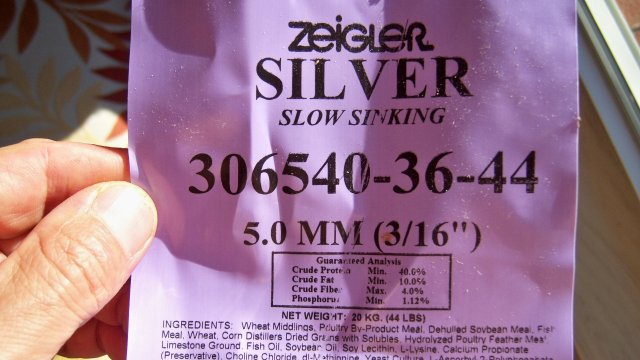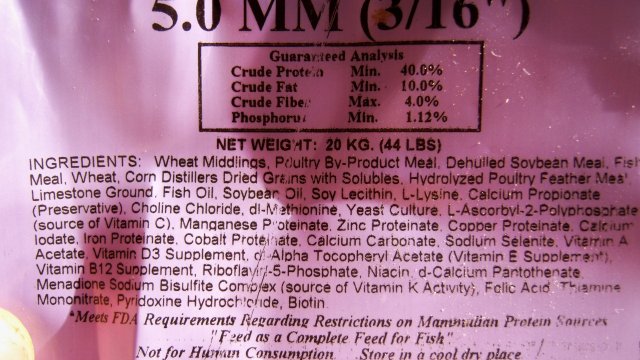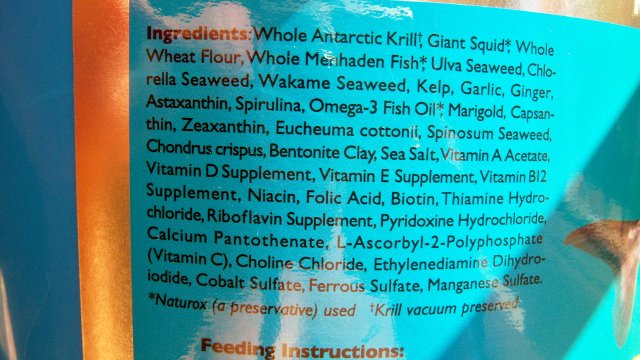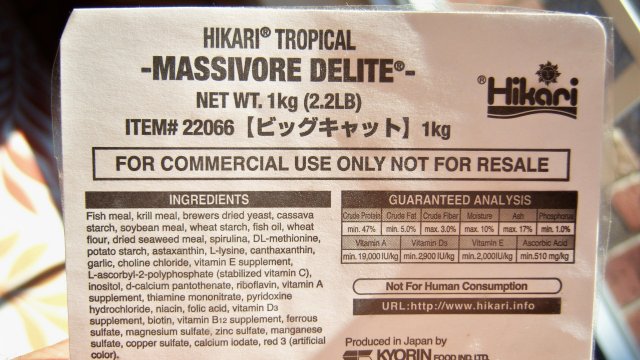So I had been suffering and finally have completed an experience-based, 180 degree change of heart with respect to what I feed my fish. Not overnight but over the last year or so, little by little. Being arrogant, stupid, and stubborn, I had to learn from my own experience.
Although I listened to what others and most notably RD.
had said about the proper fish nutrition for years and thought it must have been right, I yet continued in my own ways for many years, I guess, thinking how bad can cheap fish food be?
RD.
had said about the proper fish nutrition for years and thought it must have been right, I yet continued in my own ways for many years, I guess, thinking how bad can cheap fish food be?
Well, the conclusion is: it is bad enough that I feel I am done with it and the savings are not worth it… even based on financial considerations, which may seem counterintuitive but the main reason behind the change involves fish losses, I mean losses of large, show-size adult fish, which took me many years to raise, to unknown reasons one of which could surely be a poor long-term diet. Saving money on fish food cuts the lifespan of many fish IME by 2x to 10x to more, not to mention an overall poorer health and weaker immune system and, hence, more headache, time, and money spent on treatment and medications.
...
In the following list of fish we have lost, not all of them probably died directly from poor diet yet the diet still carries some blame in my best judgment:
- two azul pbass, 24”, four Orinoco pbass, 18”-24”, ocellaris pbass w/c in Suriname, 24”, farmed pbass, 24”, all died of natural-looking causes at ~5 years old (the farmie was ~3 years old), ate almost exclusively thawed wholesome marine baitfish, I suspect some nutrient deficiency has developed over time;
- three spiny eels, black spot and tiretrack, 18”-30”, all died of natural-looking causes at ~5 years old, ate almost exclusively Zeigler aquaculture pellets, I suspect fat deposition around internal organs and general gastrointestinal degradation developed over time;
- a few dozen of koi, 12”-30”, 10-15 years old, ate Ziegler pellets, died from an unidentified internal illness sometimes accompanied by large intestinal tumors, I suspect fat deposition around internal organs;
- carpintis / green texas cichlid, 5 years old, 12”, ate almost exclusively Ziegler pellets, developed exceedingly distended stomach area;
- two Vieja melanura synspillum, 14”, 5 and 6 years old, Ziegler pellets, greatly distended tummy;
- two TSN catfish, 24” & 34”, one died at 5 years old, the other at 7 years old, both early in life ate whole marine bait fish, later switching to mostly Ziegler pellets, I suspect fattening of the internal organs;
- TSN x achara hybrid catfish, 30”, 7 years old, Ziegler pellets;
- TSNxRTC hybrid catfish, 36”, 7 years old, mostly Ziegler pellets;
- four sun catfish, 15”-17”, 5 years old, mostly on Ziegler pellets, developed exceedingly distended stomach area, 90% of the inside of the cavity was occupied by fat;
- a few bala sharks, 12”, 5 years old or so, mostly on Ziegler pellets;
- two gulper catfish, 8”, 3 years old, on whole marine bait fish, I suspect a bad nutrient deficiency had developed;
- umbee cichlid, 18”, 4 years old, Ziegler pellets;
- four apurensis catfish 18”-23”, 3 years old, whole marine bait fish;
- four brown bullhead, 12”-14”, 3 years old, Ziegler pellets;
- two bolt catfish, 17”, 3 years old, Ziegler pellets and whole marine bait fish;
- two west African lungfish, 30”-40”, Ziegler pellets;
- barramundi, 36”, 4 years old, whole marine bait fish;
- Nile perch, 24”, 2 years old, whole marine fish;
- two indian grey eel-tail catfish, 30”, 4 years old, Ziegler pellets and whole marine bait fish;
- Pterodoras granulosus catfish, 30”, 5 years old, Ziegler pellets;
- Asian RTC, 34”, 5 years old, Ziegler pellets and sometimes whole marine fish.
The photos and final measurements of these fish can be seen in this thread -- https://www.monsterfishkeepers.com/forums/posts/7754696 -- and all details can be found in our threads dedicated to these fish in the respective subforums.
I am not stating that all these fish died directly from the poor diet but I guess at least half of them have died directly because of it and in others it was a crucial factor of two or more factors.
...
Fixing the whole marine bait fish part has been rather easy for me. I just pre soak them in VitaChem now.
Fixing the pellet part is where I need guidance and help. I have already asked one question toward this goal here: https://www.monsterfishkeepers.com/...ir-ingredient-pellet-lists-be-trusted.728018/
I had stopped feeding the $1/lb Ziegler pellets altogether and have been feeding the $10-$12/lb NLS exclusively for the last couple of months. This has increased our pellet cost by about 5x (10x more expensive pellets but I can use 2x less of it). Thus, we have gone from ~$80 a month to $400 a month spent on pellets.
Now I am prepared to pay that much for the new pellets, no problem, I’d much rather treat our fish the best I can and calm my conscience, which had not been entirely calm about feeding cheapo pellets for many years.
[1] But RD. says this is an overkill for the f/w fish (it’d be adequate for the much more demanding and touchy marine fish in his opinion). [2] Moreover, as you can see from that other thread I linked discussing the Aquatic Foods and Blackworm Co. (AFBC) pellets, if I could get away with as low as $4/lb and it would still be deemed adequate by experts, then why not? I don’t want to throw money away either. We work hard to make it. It doesn’t fall from the sky on us.
As you can see too from the AFBC thread, RD. also advises me to approach a manufacturer directly and see if I could buy the pellets in bulk from them omitting the middle men. Can this be done with the NLS? Also, I thought I first should zero in on 1, 2, or 3 manufacturers and then consider approaching them. As you can see our volumes are not that great at all, we are a tiny place for a Public Aquarium, really. A few hundred $ a month I am dubious would entice any manufacturer into a collaboration, except maybe advertising but we are not even yet open for business to public at large.
...
I will attach below the ingredient lists of our former staple Ziegler pellets and of the new NLS pellets. The ingredient lists of three types of exemplary AFBC pellets can be found in the thread I linked.
I don’t see how Hikari is any better. From the ingredient list alone it looks inferior to the NLS and it is as expensive or more expensive.
Hikari Cichlid Gold is a bit more than $9/lb in bulk.
Hikari Cichlid Excel is $13/lb.
Hikari Massivore is of course even more expensive at $25/lb in bulk.
Finally, about 1/2 of all pellets goes to our koi and carp. Is the primarily cichlid-targeted NLS pellet good for them (not algae max but more of generic, middle of the way pellet)? Is it reasonable financially to feed koi, mahseer, and Co. with them? Perhaps someone could advise me on what koi/carp pellets would be the best in, first, the quality and, second, the price.
Ideally, it’d be good to stay with one pellet fits all, or at least with two kinds – for koi and carp and for everyone else, which are primarily carnivore and omnivore.




Although I listened to what others and most notably
Well, the conclusion is: it is bad enough that I feel I am done with it and the savings are not worth it… even based on financial considerations, which may seem counterintuitive but the main reason behind the change involves fish losses, I mean losses of large, show-size adult fish, which took me many years to raise, to unknown reasons one of which could surely be a poor long-term diet. Saving money on fish food cuts the lifespan of many fish IME by 2x to 10x to more, not to mention an overall poorer health and weaker immune system and, hence, more headache, time, and money spent on treatment and medications.
...
In the following list of fish we have lost, not all of them probably died directly from poor diet yet the diet still carries some blame in my best judgment:
- two azul pbass, 24”, four Orinoco pbass, 18”-24”, ocellaris pbass w/c in Suriname, 24”, farmed pbass, 24”, all died of natural-looking causes at ~5 years old (the farmie was ~3 years old), ate almost exclusively thawed wholesome marine baitfish, I suspect some nutrient deficiency has developed over time;
- three spiny eels, black spot and tiretrack, 18”-30”, all died of natural-looking causes at ~5 years old, ate almost exclusively Zeigler aquaculture pellets, I suspect fat deposition around internal organs and general gastrointestinal degradation developed over time;
- a few dozen of koi, 12”-30”, 10-15 years old, ate Ziegler pellets, died from an unidentified internal illness sometimes accompanied by large intestinal tumors, I suspect fat deposition around internal organs;
- carpintis / green texas cichlid, 5 years old, 12”, ate almost exclusively Ziegler pellets, developed exceedingly distended stomach area;
- two Vieja melanura synspillum, 14”, 5 and 6 years old, Ziegler pellets, greatly distended tummy;
- two TSN catfish, 24” & 34”, one died at 5 years old, the other at 7 years old, both early in life ate whole marine bait fish, later switching to mostly Ziegler pellets, I suspect fattening of the internal organs;
- TSN x achara hybrid catfish, 30”, 7 years old, Ziegler pellets;
- TSNxRTC hybrid catfish, 36”, 7 years old, mostly Ziegler pellets;
- four sun catfish, 15”-17”, 5 years old, mostly on Ziegler pellets, developed exceedingly distended stomach area, 90% of the inside of the cavity was occupied by fat;
- a few bala sharks, 12”, 5 years old or so, mostly on Ziegler pellets;
- two gulper catfish, 8”, 3 years old, on whole marine bait fish, I suspect a bad nutrient deficiency had developed;
- umbee cichlid, 18”, 4 years old, Ziegler pellets;
- four apurensis catfish 18”-23”, 3 years old, whole marine bait fish;
- four brown bullhead, 12”-14”, 3 years old, Ziegler pellets;
- two bolt catfish, 17”, 3 years old, Ziegler pellets and whole marine bait fish;
- two west African lungfish, 30”-40”, Ziegler pellets;
- barramundi, 36”, 4 years old, whole marine bait fish;
- Nile perch, 24”, 2 years old, whole marine fish;
- two indian grey eel-tail catfish, 30”, 4 years old, Ziegler pellets and whole marine bait fish;
- Pterodoras granulosus catfish, 30”, 5 years old, Ziegler pellets;
- Asian RTC, 34”, 5 years old, Ziegler pellets and sometimes whole marine fish.
The photos and final measurements of these fish can be seen in this thread -- https://www.monsterfishkeepers.com/forums/posts/7754696 -- and all details can be found in our threads dedicated to these fish in the respective subforums.
I am not stating that all these fish died directly from the poor diet but I guess at least half of them have died directly because of it and in others it was a crucial factor of two or more factors.
...
Fixing the whole marine bait fish part has been rather easy for me. I just pre soak them in VitaChem now.
Fixing the pellet part is where I need guidance and help. I have already asked one question toward this goal here: https://www.monsterfishkeepers.com/...ir-ingredient-pellet-lists-be-trusted.728018/
I had stopped feeding the $1/lb Ziegler pellets altogether and have been feeding the $10-$12/lb NLS exclusively for the last couple of months. This has increased our pellet cost by about 5x (10x more expensive pellets but I can use 2x less of it). Thus, we have gone from ~$80 a month to $400 a month spent on pellets.
Now I am prepared to pay that much for the new pellets, no problem, I’d much rather treat our fish the best I can and calm my conscience, which had not been entirely calm about feeding cheapo pellets for many years.
[1] But RD. says this is an overkill for the f/w fish (it’d be adequate for the much more demanding and touchy marine fish in his opinion). [2] Moreover, as you can see from that other thread I linked discussing the Aquatic Foods and Blackworm Co. (AFBC) pellets, if I could get away with as low as $4/lb and it would still be deemed adequate by experts, then why not? I don’t want to throw money away either. We work hard to make it. It doesn’t fall from the sky on us.
As you can see too from the AFBC thread, RD. also advises me to approach a manufacturer directly and see if I could buy the pellets in bulk from them omitting the middle men. Can this be done with the NLS? Also, I thought I first should zero in on 1, 2, or 3 manufacturers and then consider approaching them. As you can see our volumes are not that great at all, we are a tiny place for a Public Aquarium, really. A few hundred $ a month I am dubious would entice any manufacturer into a collaboration, except maybe advertising but we are not even yet open for business to public at large.
...
I will attach below the ingredient lists of our former staple Ziegler pellets and of the new NLS pellets. The ingredient lists of three types of exemplary AFBC pellets can be found in the thread I linked.
I don’t see how Hikari is any better. From the ingredient list alone it looks inferior to the NLS and it is as expensive or more expensive.
Hikari Cichlid Gold is a bit more than $9/lb in bulk.
Hikari Cichlid Excel is $13/lb.
Hikari Massivore is of course even more expensive at $25/lb in bulk.
Finally, about 1/2 of all pellets goes to our koi and carp. Is the primarily cichlid-targeted NLS pellet good for them (not algae max but more of generic, middle of the way pellet)? Is it reasonable financially to feed koi, mahseer, and Co. with them? Perhaps someone could advise me on what koi/carp pellets would be the best in, first, the quality and, second, the price.
Ideally, it’d be good to stay with one pellet fits all, or at least with two kinds – for koi and carp and for everyone else, which are primarily carnivore and omnivore.






